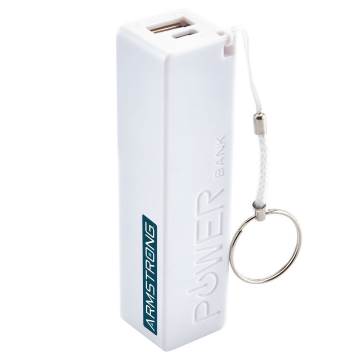You Are Here: Greyghost > Product Reviews > Harbor Freight Armstrong 2000mAH Power Bank Review
Harbor Freight Armstrong 2000 mAH Power Bank Review
Rating: 
Harbor Freight Tools recently
launched a new product line consisting of various chargers and
battery-supplied power banks under the "Armstrong" name. One wonders if
they got the joke*.
Today I'm going to be looking at the
smallest power bank they sell, the 64977. This model is rated for a
2000 milliamp-hour capacity (or two amp-hours). As of this writing,
I've seen this power bank offered in their stores for $5 and on their
web site for $7.

If you ask for the full rated
capacity of the power bank all at once, you certainly won't get two
amps out of it for an hour. There's always some inflation of the
specifications as to much energy these things can deliver and for how
long. In testing the power bank with a 500 mA dummy load, it managed to
deliver about 1200 mAH before shutting off with an exhausted battery.
Charging it showed about 1700 mAH worth of current going in over time,
so I'd hazard a guess that the actual battery within has around 1500
mAH worth of capacity. Compared to the other power banks I have, the
fib factor is no worse than any of them. Like most others, this bases
on a lithium ion battery. There is a converter circuit within to boost
the battery's voltage (from 3.7 to 5 volts or so) and to reduce the
input voltage when the battery is being charged.
This power bank won't have capacity
sufficient to bring most cellular phones back to a full charge, though
it will certainly get you out of a tight spot if you've run out battery
and need a little boost until the next time you can get to a charger.
The original USB specification calls
for devices to receive 100mA worth of current without asking and up to
500 mA with permission from a host controller in a computer or similar
device. Either one works out to pretty slow charging, and as far as I'm
aware, no USB attached device makes such a request, nor does any USB
host controller actually grant it. Most anything just takes what it
wants, right up to the 500mA. A few "rude" devices just assume there's
still more current available, and that they can just take it. More
polite devices use a variety of different methods to ascertain whether
more than 500mA worth of current is available from a given port, and to
request that more power be made available for their needs. The result
is a shorter charging time.
The Armstrong power bank fits into
both categories. When charging, it drew nearly one amp from a laptop's
USB port. This quickly tapered down to 750 mA or so and stayed around
there until the very end of the charging cycle. Its output is coded to
indicate support for Dedicated Charging Port, or DCP, functionality at
up to 1.5 amps. Although the power bank is capable of delivering that
much current, its connection points become quite warm in doing so and
the internal battery won't manage it for long. Attached devices will
get more out of it (albeit at a slower rate) if they limit their
charging current to much less than the maximum.
Some approaches to high speed USB
charging, such as Qualcomm's Quick Charge, also increase the voltage
output when possible. This power bank does not support any of those
methods. There is no means by which a device using USB-C can be
attached. Most USB-C devices would also request a higher voltage
output, and this power bank cannot provide that. (To my knowledge,
Harbor Freight does not sell any charger or power bank that supports
USB-C charging.)
For no more than it costs, and its
comparable performance to other USB power banks of similar rating, this
seems to be an entirely decent product. I've used mine several times so
far, and while only time will tell, it has just done exactly what it
was supposed to by providing a decent boost in battery capacity for a
variety of different devices. I've even run a Raspberry Pi 4 from it
for short periods of time.
Go Back > (to the top level index page)
Copyright © 2020 by William R.
Walsh. Some rights reserved. Please see the terms and conditions
available from the top level page of this site for information about
your rights to use and re-use this material.
* The historical reference to an "Armstrong" battery as I had come to
understand it had to do with early farm tractors (and cars) whose
engines were started by hand-cranking them. Early tractors in
particular oftentimes had no storage battery or electrical system
beyond that needed to produce high voltage for ignition purposes. Thus,
the joke about an "arm strong" battery providing the energy needed to
spin the engine over and get it started. Perhaps the joke is less
common than I expected or it has been largely forgotten. In preparing
this review, I really expected to find some references to this
elsewhere online, especially given the number of antique tractor and
automobile forums. This demonstrates more of my boundless optimism, in
spite of a strong belief driven by experience that Google searches are
increasingly useless.

